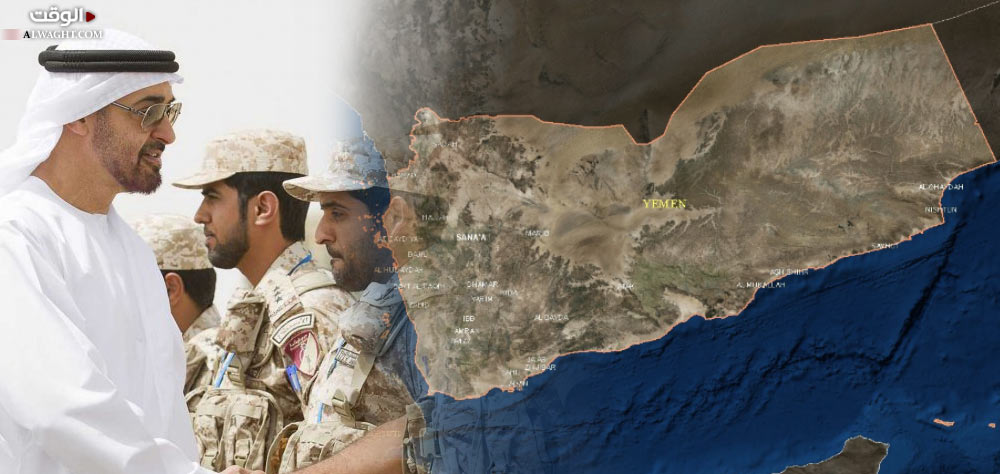Alwaght- Saudi-led Arab military coalition's aggression in 2015 ushered in a series of new developments in Yemen. A couple of months after start of the war which changed Yemen into a scene of asymmetrical military confrontation, the country met an array of its specific highs and lows.
The Ansarullah movement and the Yemeni army managed to resist and keep many cities from falling to the Arab coalition despite a glaringly apparent imbalance with the opposite side in terms of the equipment and weapons. However, the battle for Aden province changed the course of war as Ansarullah had to retreat from its positions there. This, in fact, marked a turning point in the Yemen’s military developments and led to losing more regions to the opposite side in southern parts of the country.
The United Arab Emirates, a small country laying on the southern coasts of the Persian Gulf that obviously relies on the transregional powers for self-protection, in recent years has been working on expansion of its regional role playing. In 2011, the UAE joined Saudi-led Arab bloc in its deployment of forces to Bahrain to suppress the peaceful uprising in the tiny neighboring emirate. And in later years, Yemen's domestic unrest and then struggles made the UAE engaged more in a campaign of regional intervention.
Abu Dhabi's leaders shared some objectives, including the need to stifle Ansarullah control over Yemen, deter the rival parties' influence in the Arab world, and fight any possibility of Yemen chaos spillover to other Arab states, with the members of the (Persian) Gulf Cooperation Council, but at the same time had goals and concerns unique to their strategy in Yemen, something pushed them to get involved in direct military intervention and play a wide-ranging role in the fighting for south of the war-ravaged country.
Setting own goals and aiming at specific interests caused some rifts between the UAE and Saudi Arabia and pushed them into a significant game of rivalry for expansion of toehold in Yemen. The Emiratis have cultivated two collections of considerations, one political and the other economic, in relation to Yemen. And by the way, their new approach to Yemen war after Aden battle is linked to these considerations. Their most important political efforts in Yemen was preventing Yemenis from forming a strong and stable national government, fight the rise of Muslim Brotherhood, fuel clashes between the al-Qaeda terrorist group and forces loyal to the resigned and fugitive Yemeni President Abed Rabbuh Mansur Hadi and also the southern separatists, and work for south to separate from north.
From economic aspects, the UAE is concerned the stability could mean Yemen economic growth. This could present Yemen as an independent party with potentials to take on the UAE economically thanks to its geopolitical position. This can happen in a smaller size as a stable Aden, a significant port city with potentials to develop as a platform hosting merchant vessels, could stand rival to Dubai which is a regional trade hub and source of enormous incomes to the Arab sheikhdom. This is a strong drive for the Emirati rulers to keep Aden and other coastal regions from a state of stability and independence of policy making. Al Noor City project can transform the region’s economic status. This has been source of worries by Emirati leaders fearing loss of economic centrality.
Al Noor City enterprise was planned in 2006 when the former President Ali Abdullah Saleh organized a meeting with nearly 150 global investment and construction companies. Abdullah Ahmad Bugshan, a Saudi-Yemeni tycoon, was picked as project contractor. The venture's expenditures were predicted $140 billion and it wanted to link the Horn of Africa to the Arab Peninsula through a bridge that connects two coastal cities one in Djibouti and the other in Yemen. The blueprints show that the Al Noor City is several times as big as Dubai, with its foreseen management center being Aden's Alhurra district. The UAE has gone to great lengths to stop the project using its Dubai Ports World (DP World) giant.
In fact, there is another face for the Emirati involvement in Yemen war: to tackle Saudi Arabian influence. Abu Dhabi does not want Riyadh to alone make decisions for Yemen. This desire showed itself by the UAE struggle to get a foothold in southern Yemen and among the tribes there in the face of Saudi attempts for sway in northern parts. Clearly, support for southern separatists serves this Emirati agenda in Yemen.
Now the UAE controls Yemen’s oil-rich areas with 3,000 armed mercenaries. Reports suggest that it wants to exclude them from the Yemeni territories altogether with their active oilfields. It also occupies Aazan and Hoban districts in Shabwa province in eastern Yemen which could contribute to Yemen split. But pro-UAE forces declined so far to approach the Ansarullah-controlled areas.
Abu Dhabi initially announced joining the Arab coalition by maintaining that it sought to help Yemen restore peace and stability and reach a political settlement according to the (P) GCC initiative. It sent 30 fighter jets and several thousand combat troops, and developed initiatives to get further political influence in Yemen but so far failed to effectively address its objectives. The Emiratis, however, began to grow concerned as domestic critics warn that a war of attrition is likely in Yemen and fighting in southern areas could intensify, something they never want as they project trouble once the circle of fighting broadens.
Besides, it appears that military measures and role playing in Yemen war have domestic consumption. Under public opinion pressures for war costs and battlefield failures, Emirati officials by their Yemen adventures want to exhibit a successful picture of their Yemen campaign. By spreading news of seizing oilfields, they want to justify the war spending for their people. Though UAE's goals for joining the anti-Yemen coalition go beyond the mentioned cases.



























